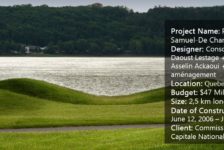Following his interview on working as one of the lead planting design consultants for the London 2012 Olympic Park, Professor Nigel Dunnett shares his passion and background on planting design, along with his philosophy and approach on the landscape profession. Nigel is a professor at University of Sheffield, as well as being the director of the Green Roof Center at the University. With his strong horticulture and ecological background, his most well known designs has been the Royal Bank of Canada at the London Wetland Center and gardens for The Chelsea Flower Show and of course, London Olympic Park.
- What determined your passion for this field?
I’ve been interested in plants and nature since I was very small. I grew up in the countryside in the UK in a village and my parents were both keen on gardening and I guess I had that in me from an early age about working with plants. Some of my earliest memories were about growing plants and making more plants. I suppose I was always keen on growing plants because I had a horticulture background.
When I went to University, I decided what to do. I could have studied landscape architecture or I could have studied horticulture or design but I kind of thought I could teach myself all of that just by reading, doing and visiting. So I first of all had scientific training- I studied plant science. For my Masters I studied Landscape Ecology and Landscape Management and then came to Sheffield University to do a PhD in plant ecology. So actually my whole background and training is in science but my whole experience and working has been in the design field with working with planting design, horticulture and landscape management.
- So do you think you can teach someone to be a designer or do you think people can, like you mentioned, teach themselves?
I can see just by working here that a lot of students come with an inbuilt talent and maybe it’s just the case of adding some technical knowledge and guidance. I really do feel that a lot of informed design has to have a very strong theoretical background. So you can design conceptually and it can be done very successfully, but if it isn’t glued with some form of reality or theory or background knowledge, and all there is present is a concept, then that’s how it will stay. I think it’s like being an artist, people have it within them, and maybe the training is about liberating some of that creativity within.
- What or who has been your biggest inspiration? Or do you have any at all?
Let me think…the cliché is that you have inspiration from nature, and I think that has to be true. I’ve also been inspired by a few artists, like Bridget Riley who is a modern painter. She works with patterns and a lot of repeating in color that is very similar to the way I think about planting. It always has to go back to being inspired by nature. For me it’s not about looking at a scene and trying to copy it. It’s about the process and how it works- the dynamics of nature which changes through time and I’m kind of fascinated by the succession of change through time. I’m also inspired and fascinated by small scale details- like seeing a tree and how moss or ivy would grow on the trunk of a tree, that kind of detail at a small scale- for some reason, I just find that really inspiring as well.
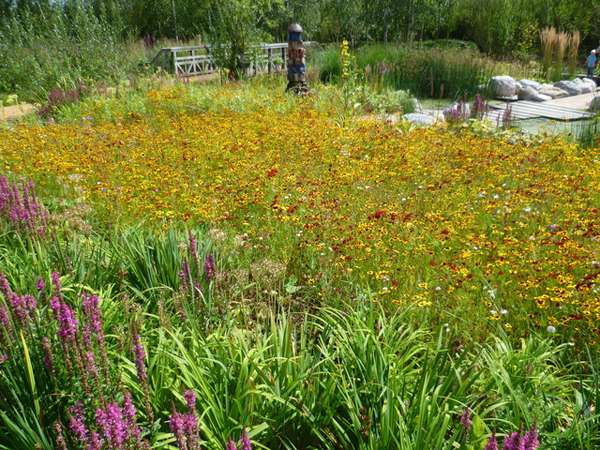
RBC Rain Garden at the London Wetland Centre © Copyright Marathon and licensed for reuse under this Creative Commons Licence. Photo credit: Ian Yarham – Geograph
- You are a knowledgeable professor on planting design. What is your design philosophy of planting?
It is ultimately about creating this exciting and uplifting feeling- it has to be. It’s about making things, which are so exciting that they make people feel “Wow, I’ve never seen anything like it!” And it is about doing things that make people feel surprised by the beauty of planting. So it’s about the beauty and the aesthetics. A lot of the work I do is planting within a design context- how you experience that and how you go through it and interact with the process can be a very emotional thing. The philosophy beyond that, of course, is about sustainability and about minimizing water and fertilizers and maintenance. Planting should also be done to enhance biodiversity, supporting pollinating insects and such. So in the end, it is the dynamic combination between the aesthetics and the natural processes.
- What are some of the determining factors for plant and material selection for a particular project?
Well, there’s always a vision in my head that I want to achieve. I’m very interested in color I must admit, it’s very important to me, and I do work very hard to think about color combinations. That is often the first step- coming up with some sort of a color combination that can be very striking and challenging or very soft and very gentle. Then of course, you have to think about the contrast and the forms and the textures. It’s very important that you have a good contrast between the planting forms and textures. I guess for me it’s that dynamic quality of changes over time; the fact that what we do will look good for most of the year but it will also look different at different times of the year. But definitely, it’s becoming more and more about color that I’m interested in.
- Can you talk about how the landscape profession has changed over the years- and has this affected you?
I think the big thing is that more and more people are recognizing the value of green infrastructure and planting, such as green roofs and rain gardens. People are gradually starting to realize that these landscape led approaches are very valuable. There have been big movements of landscape urbanism, ecological urbanism. In particular I think ecological urbanism is one of these ones which have staying power, where the landscape architects are the only people who can really play a role. It’s about connectivity and joining spaces up and thinking about special arrangements first then the buildings come around that. That kind of design setting is really where landscape architects come in. The Olympic Park was one of the projects where landscape architects led the project rather than coming in at the end. The landscape architects were the people setting the framework. Sometimes the ecological approach is very fashionable then becomes unfashionable. But I think it is going beyond fashion now, to being absolutely integral.
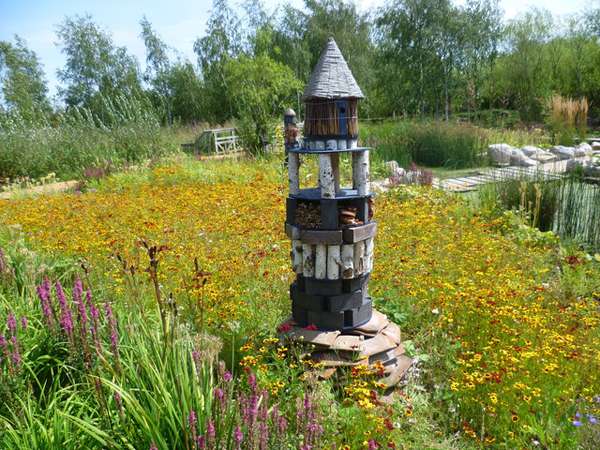
RBC Rain Garden at the London Wetland Centre © Copyright Marathon and licensed for reuse under this Creative Commons Licence. Photo credit: Ian Yarham – Geograph
- What advice do you have to give to young designers and students reading this interview?
It’s about being passionate. Sometimes with students it can be very difficult to sense that passion and that excitement. Be bold and have strong ideas and don’t be timid about these ideas. That’s the danger with all of this stuff- there’s so much timidity and caution. So liberate yourself to be creative but recognize where you need that knowledge and support. Hopefully, this interview has been a source of inspiration for all. What Nigel has shared uncovers some truths about this broad field of the landscape profession and the fact that there is always much to be explored and discovered; what hasn’t been created can still be done. Check out Nigell Dunnett’s book in collaboration Noel Kingsbury – Planting Green Roofs and Living Walls by Nigel Dunnett and Noël Kingsbury Interview conducted by Win Phyo
This article was originally submitted to Landscape Architects Network
Published in Blog



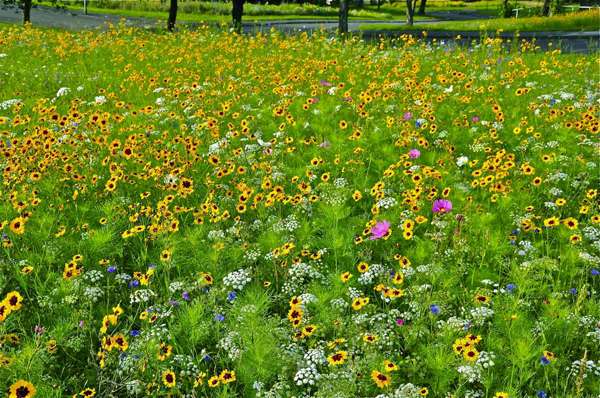


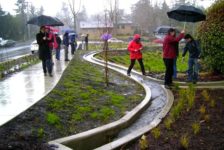


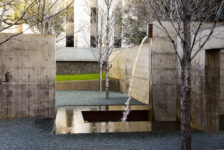



![The Next Green Revolution [Video]](https://land8.com/wp-content/uploads/2018/01/Thomas-Rainer-Land8x8-224x150.png)
